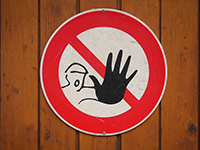 The vast majority of workplace injuries are not the broken legs and cuts that need stitches, but the banged thumbs, nicked fingers and twisted ankles that take place during the most routine tasks. You know to be safe around a pneumatic drill, you know to be safe around the spot welding equipment. Not everyone knows to pace themselves when using a simple hammer or a power drill. They say that most car accidents take place near the home, where you’re comfortable and you let your guard down. It’s the same with construction work: The most dangerous job is frequently the one that you’ve done a million times.
The vast majority of workplace injuries are not the broken legs and cuts that need stitches, but the banged thumbs, nicked fingers and twisted ankles that take place during the most routine tasks. You know to be safe around a pneumatic drill, you know to be safe around the spot welding equipment. Not everyone knows to pace themselves when using a simple hammer or a power drill. They say that most car accidents take place near the home, where you’re comfortable and you let your guard down. It’s the same with construction work: The most dangerous job is frequently the one that you’ve done a million times.
Never Neglect Your Safety Gear
A stray piece of sawdust when using a power drill or a circular saw can lead to serious eye injury. Don’t let your workers do anything without the proper safety gear. If you’re working with wood, safety goggles and gloves are a must.
Make Time
No matter how small a job may seem, allow yourself the proper amount of time to get it done the right way. A little bit of breathing room can make all the difference between finishing a job safely, and doing it correctly, and rushing so that a simple task becomes impossibly difficult, and surprisingly dangerous.
Check Your Equipment
A cracked hammer, a screwdriver with a loose grip, is a serious injury just waiting to happen. Keep an eye on your hand tools and make sure to replace any tools that have seen better days, whether it’s a pry-bar or a socket wrench.
Maintain A Strict Sobriety Stance
You’ve probably seen buddies who could drink three beers and then raise a barn roof one-handed. That’s a neat trick, but it’s not worth the risk on a professional job site. The liability issues that come with drugs and alcohol on the job site simply are not worth the trouble. Even if an employee suffers an injury that might have happened whether or not they were sober, that’s not a question you want to be asking yourself, and it’s not a question that the judge is going to bother asking. Knock a few back after work, but keep the job site sober.
Common sense, caution and basic safety procedures will help to reduce not only the big on-site injuries, the scaffolding falls and the heavy machinery slip-ups, but the sliced fingers and busted thumbs, as well.





